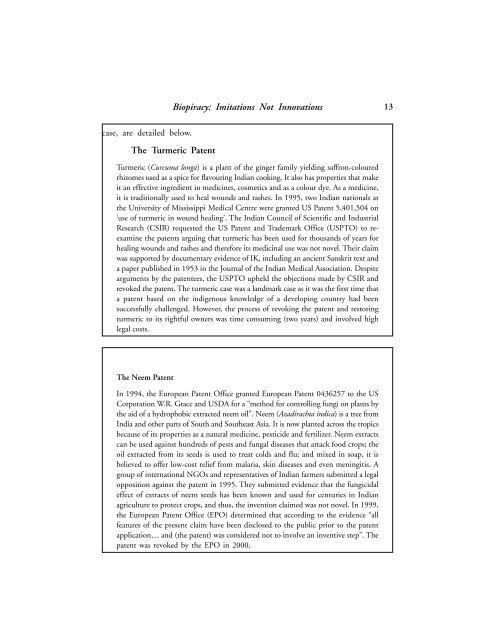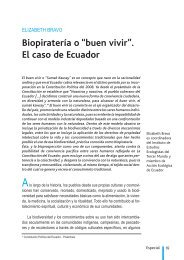BIOPIRACY Imitations Not Innovations - Biopirateria
BIOPIRACY Imitations Not Innovations - Biopirateria
BIOPIRACY Imitations Not Innovations - Biopirateria
You also want an ePaper? Increase the reach of your titles
YUMPU automatically turns print PDFs into web optimized ePapers that Google loves.
Biopiracy: <strong>Imitations</strong> <strong>Not</strong> <strong>Innovations</strong> 13<br />
case, are detailed below.<br />
The Turmeric Patent<br />
Turmeric (Curcuma longa) is a plant of the ginger family yielding saffron-coloured<br />
rhizomes used as a spice for flavouring Indian cooking. It also has properties that make<br />
it an effective ingredient in medicines, cosmetics and as a colour dye. As a medicine,<br />
it is traditionally used to heal wounds and rashes. In 1995, two Indian nationals at<br />
the University of Mississippi Medical Centre were granted US Patent 5,401,504 on<br />
‘use of turmeric in wound healing’. The Indian Council of Scientific and Industrial<br />
Research (CSIR) requested the US Patent and Trademark Office (USPTO) to reexamine<br />
the patents arguing that turmeric has been used for thousands of years for<br />
healing wounds and rashes and therefore its medicinal use was not novel. Their claim<br />
was supported by documentary evidence of IK, including an ancient Sanskrit text and<br />
a paper published in 1953 in the Journal of the Indian Medical Association. Despite<br />
arguments by the patentees, the USPTO upheld the objections made by CSIR and<br />
revoked the patent. The turmeric case was a landmark case as it was the first time that<br />
a patent based on the indigenous knowledge of a developing country had been<br />
successfully challenged. However, the process of revoking the patent and restoring<br />
turmeric to its rightful owners was time consuming (two years) and involved high<br />
legal costs.<br />
The Neem Patent<br />
In 1994, the European Patent Office granted European Patent 0436257 to the US<br />
Corporation W.R. Grace and USDA for a “method for controlling fungi on plants by<br />
the aid of a hydrophobic extracted neem oil”. Neem (Azadirachta indica) is a tree from<br />
India and other parts of South and Southeast Asia. It is now planted across the tropics<br />
because of its properties as a natural medicine, pesticide and fertilizer. Neem extracts<br />
can be used against hundreds of pests and fungal diseases that attack food crops; the<br />
oil extracted from its seeds is used to treat colds and flu; and mixed in soap, it is<br />
believed to offer low-cost relief from malaria, skin diseases and even meningitis. A<br />
group of international NGOs and representatives of Indian farmers submitted a legal<br />
opposition against the patent in 1995. They submitted evidence that the fungicidal<br />
effect of extracts of neem seeds has been known and used for centuries in Indian<br />
agriculture to protect crops, and thus, the invention claimed was not novel. In 1999,<br />
the European Patent Office (EPO) determined that according to the evidence “all<br />
features of the present claim have been disclosed to the public prior to the patent<br />
application… and (the patent) was considered not to involve an inventive step”. The<br />
patent was revoked by the EPO in 2000.



